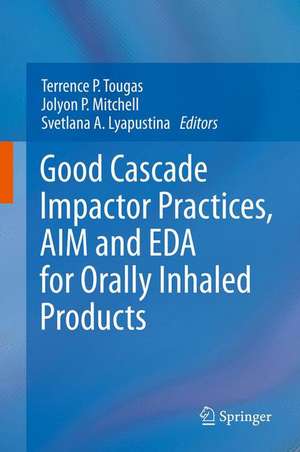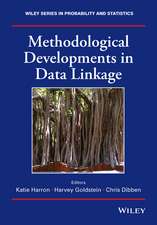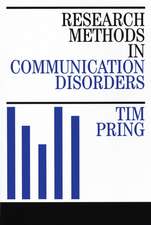Good Cascade Impactor Practices, AIM and EDA for Orally Inhaled Products
Editat de Terrence P. Tougas, Jolyon P. Mitchell, Svetlana A. Lyapustinaen Limba Engleză Hardback – 10 apr 2013
| Toate formatele și edițiile | Preț | Express |
|---|---|---|
| Paperback (1) | 952.09 lei 6-8 săpt. | |
| Springer Us – 23 aug 2016 | 952.09 lei 6-8 săpt. | |
| Hardback (1) | 1104.84 lei 6-8 săpt. | |
| Springer Us – 10 apr 2013 | 1104.84 lei 6-8 săpt. |
Preț: 1104.84 lei
Preț vechi: 1162.99 lei
-5% Nou
Puncte Express: 1657
Preț estimativ în valută:
211.48€ • 229.79$ • 177.76£
211.48€ • 229.79$ • 177.76£
Carte tipărită la comandă
Livrare economică 19 aprilie-03 mai
Preluare comenzi: 021 569.72.76
Specificații
ISBN-13: 9781461462958
ISBN-10: 1461462959
Pagini: 433
Ilustrații: XII, 442 p.
Dimensiuni: 155 x 235 x 30 mm
Greutate: 0.68 kg
Ediția:2013
Editura: Springer Us
Colecția Springer
Locul publicării:New York, NY, United States
ISBN-10: 1461462959
Pagini: 433
Ilustrații: XII, 442 p.
Dimensiuni: 155 x 235 x 30 mm
Greutate: 0.68 kg
Ediția:2013
Editura: Springer Us
Colecția Springer
Locul publicării:New York, NY, United States
Public țintă
ResearchCuprins
Introduction.- Current Approaches To APSD Measurement of OIPs Based on Inertial Impaction.- Physical Causes of APSD Changes in Aerosols From OIPs and their Impact on Cascade Impactor Measurements.- Good Cascade Impactor Practices.- The AIM and EDA Concepts: Why they are Needed.- Product Lifecycle Approach to Cascade Impaction Measurements.- Theoretical Basis for the EDA Concept.- Performance Characterization of EDA and its Potential to Improve Decision Making in Product Batch Release.- Verification of the EDA Concept through an Assessment of Theoretical Failure Modes, Failure Mode Analysis and Case Studies with Real Data.- Validating AIM-Based Instrumentation and Associated Measurement Techniques.- The Regulatory and Compendial Acceptance Pathways for AIM and EDA.- Applying the AIM Concept in Support of Developing Improved In Vitro-In Vivo Relationships for OIPs.- Future Directions for the AIM and EDA Concepts.- Conclusions.
Notă biografică
Terrence P. Tougas, Ph.D.
Terrence Tougas, Ph.D. is a Highly Distinguished Research Fellow in Analytical Development at Boehringer Ingelheim Pharmaceuticals, Ridgefield, CT where he has over 20 years of experience and currently heads the Stability, Submission Documents and Information Systems Group. He contributed to chemistry, manufacturing and controls sections of several New Drug Applications, including for pulmonary (metered dose inhalers, inhalation solutions and nasal sprays) and antiviral products.
Dr. Tougas is a member and past chair of the International Pharmaceutical Aerosol Consortium on Regulation and Science (IPAC-RS) Board of Directors, and has been leader or member of several IPAC-RS working groups. Dr. Tougas served on the Steering Committee and chaired the Drug Product Technical Committee of the Product Quality Research Institute (PQRI). More recently, he helped form the International Consortium on Innovation and Quality in Pharmaceutical Development (IQ), served as the first chair of its Board of Directors and is a member of the IQ Statistics Leadership Group.
Dr. Tougas authored numerous publications related to the CMC aspects of drug development, analytical chemistry and quality control statistics. He contributed chapters to books on chromatography and leachables/extractables testing of inhalation products. His background is in analytical chemistry; he holds a Ph.D in chemistry from the University of Massachusetts, Amherst.
Jolyon P. Mitchell, Ph.D.
Jolyon Mitchell, Ph.D. is Scientific Director at Trudell Medical International, London, Canada. He is involved in several industry-wide organizations involved with inhaled medical aerosol delivery, in particular the European Pharmaceutical Aerosol Group (EPAG) as well as serving as a Scientific Adviser to IPAC-RS. He played major parts in the development of an international standard (ISO 20072:2009) covering the design verification of portable inhalers, as well as a Canadian Standard for Spacers and Holding Chambers (CAN/CSA Z264.1-02:2002). He is currently a Canadian delegate to ISO/TC121/SC2, involved with the ongoing development of a standard specifically for nebulizing systems (ISO 27427). In 2010, he was recently appointed to the Expert Committee: General Chapters – Dosage Forms of the United States Phamacopeial Convention for the 2010-2015 term, where he serves as vice chair of the Aerosols dosage form sub-committee.
His background is in physical chemistry. He is a Fellow of the UK Royal Society of Chemistry, a Chartered Scientist, a founder member of the UK-Irish Aerosol Society and a member of the Gesellschaft für Aerosolforschung, American Association for Aerosol Research, American Association of Pharmaceutical Scientists and the International Society for Aerosols in Medicine. He is on the Editorial Advisory Board of Journal of Aerosol Medicine. He is also an adjunct professor at the University of Western Ontario.
Svetlana A. Lyapustina, Ph.D.
Svetlana Lyapustina, Ph.D. is a Senior Science Advisor in the Pharmaceutical Practice Group of the Washington, D.C. office of Drinker Biddle & Reath LLP. As a member of that multi-disciplinary team, Dr. Lyapustina has served as Science Advisor and Secretariat for several industry consortia, including the International Pharmaceutical Aerosol Consortium on Regulation and Science (IPAC-RS), the International Consortium for Innovation and Quality in Pharmaceutical Development (IQ), an International Pharmaceutical Supply Chain Consortium Rx-360, Alliance for Biosecurity, Nanomedicines Alliance, and Allotrope Foundation. She was an active member of the Product Quality Research Institute (PQRI), of a Project Team of the United States Pharmacopeia, and a US National Expert in the International Organization for Standardization (ISO). Dr. Lyapustina counsels clients on a wide range of topics related to drug and device product development, pharmaceutical manufacturing, regulatory compliance, quality control, bioequivalence requirements, intellectual property and other issues. Her educational background is in physical chemistry and biophysics. She has authored or co-authored numerous articles on regulatory and scientific topics in drug product development from the US, European and international perspectives, as well as articles and presentations about the process and value of cross-industry collaborations.
Terrence Tougas, Ph.D. is a Highly Distinguished Research Fellow in Analytical Development at Boehringer Ingelheim Pharmaceuticals, Ridgefield, CT where he has over 20 years of experience and currently heads the Stability, Submission Documents and Information Systems Group. He contributed to chemistry, manufacturing and controls sections of several New Drug Applications, including for pulmonary (metered dose inhalers, inhalation solutions and nasal sprays) and antiviral products.
Dr. Tougas is a member and past chair of the International Pharmaceutical Aerosol Consortium on Regulation and Science (IPAC-RS) Board of Directors, and has been leader or member of several IPAC-RS working groups. Dr. Tougas served on the Steering Committee and chaired the Drug Product Technical Committee of the Product Quality Research Institute (PQRI). More recently, he helped form the International Consortium on Innovation and Quality in Pharmaceutical Development (IQ), served as the first chair of its Board of Directors and is a member of the IQ Statistics Leadership Group.
Dr. Tougas authored numerous publications related to the CMC aspects of drug development, analytical chemistry and quality control statistics. He contributed chapters to books on chromatography and leachables/extractables testing of inhalation products. His background is in analytical chemistry; he holds a Ph.D in chemistry from the University of Massachusetts, Amherst.
Jolyon P. Mitchell, Ph.D.
Jolyon Mitchell, Ph.D. is Scientific Director at Trudell Medical International, London, Canada. He is involved in several industry-wide organizations involved with inhaled medical aerosol delivery, in particular the European Pharmaceutical Aerosol Group (EPAG) as well as serving as a Scientific Adviser to IPAC-RS. He played major parts in the development of an international standard (ISO 20072:2009) covering the design verification of portable inhalers, as well as a Canadian Standard for Spacers and Holding Chambers (CAN/CSA Z264.1-02:2002). He is currently a Canadian delegate to ISO/TC121/SC2, involved with the ongoing development of a standard specifically for nebulizing systems (ISO 27427). In 2010, he was recently appointed to the Expert Committee: General Chapters – Dosage Forms of the United States Phamacopeial Convention for the 2010-2015 term, where he serves as vice chair of the Aerosols dosage form sub-committee.
His background is in physical chemistry. He is a Fellow of the UK Royal Society of Chemistry, a Chartered Scientist, a founder member of the UK-Irish Aerosol Society and a member of the Gesellschaft für Aerosolforschung, American Association for Aerosol Research, American Association of Pharmaceutical Scientists and the International Society for Aerosols in Medicine. He is on the Editorial Advisory Board of Journal of Aerosol Medicine. He is also an adjunct professor at the University of Western Ontario.
Svetlana A. Lyapustina, Ph.D.
Svetlana Lyapustina, Ph.D. is a Senior Science Advisor in the Pharmaceutical Practice Group of the Washington, D.C. office of Drinker Biddle & Reath LLP. As a member of that multi-disciplinary team, Dr. Lyapustina has served as Science Advisor and Secretariat for several industry consortia, including the International Pharmaceutical Aerosol Consortium on Regulation and Science (IPAC-RS), the International Consortium for Innovation and Quality in Pharmaceutical Development (IQ), an International Pharmaceutical Supply Chain Consortium Rx-360, Alliance for Biosecurity, Nanomedicines Alliance, and Allotrope Foundation. She was an active member of the Product Quality Research Institute (PQRI), of a Project Team of the United States Pharmacopeia, and a US National Expert in the International Organization for Standardization (ISO). Dr. Lyapustina counsels clients on a wide range of topics related to drug and device product development, pharmaceutical manufacturing, regulatory compliance, quality control, bioequivalence requirements, intellectual property and other issues. Her educational background is in physical chemistry and biophysics. She has authored or co-authored numerous articles on regulatory and scientific topics in drug product development from the US, European and international perspectives, as well as articles and presentations about the process and value of cross-industry collaborations.
Textul de pe ultima copertă
Aerodynamic particle size characteristics of orally inhaled products (OIPs) are critical to their performance. Testing based on cascade impaction has been the primary tool used to characterize this critical quality attribute and is a regulatory expectation for Quality Control purposes. In recent years, there have been substantial efforts directed at improving aerodynamic particle size determinations.
Good Cascade Impactor Practices, AIM and EDA for Orally Inhaled Products brings together for the first time a review of best practices for performing cascade impactor testing with a thorough discussion of the recently introduced concepts of abbreviated impactor measurements (AIM) and efficient data analysis (EDA).
Topics covered include:
· Review of pharmacopeial methods (US and European) for assessment of aerodynamic particle size distribution (APSD) of OIPs.
· Physical processes that underlie aerosol formationfrom OIPs and the mechanisms that affect the APSD.
· Good cascade impactor practice (GCIP) related to either full resolution or abbreviated impactor measurements.
· Introduction of the AIM and EDA concepts.
· Selection of the type of testing through the development lifecycle of an OIP.
· Theoretical basis for EDA.
· Performance evaluation of EDA as a quality control element.
· Case studies related to the application of EDA.
· Experimental studies validating the AIM concept conducted by European Pharmaceutical Aerosol Group (EPAG) and the Cascade Impaction Working Group of the International Pharmaceutical Aerosol Consortium on Regulation and Science (IPAC-RS).
· Regulatory and compendial pathways to adoption of AIM and EDA.
· Exploration and extension of AIM as a potential approach to measures that could be more predictive of particle deposition in the human respiratory tract.
This comprehensive volume was written by a group of prominent international experts in aerosol testing led by members of the Cascade Impaction Working Group of IPAC-RS. IPAC-RS is an international association of pharmaceutical companies committed to advancing consensus-based, scientifically driven standards and regulations for orally inhaled and nasal drug products.
Good Cascade Impactor Practices, AIM and EDA for Orally Inhaled Products brings together for the first time a review of best practices for performing cascade impactor testing with a thorough discussion of the recently introduced concepts of abbreviated impactor measurements (AIM) and efficient data analysis (EDA).
Topics covered include:
· Review of pharmacopeial methods (US and European) for assessment of aerodynamic particle size distribution (APSD) of OIPs.
· Physical processes that underlie aerosol formationfrom OIPs and the mechanisms that affect the APSD.
· Good cascade impactor practice (GCIP) related to either full resolution or abbreviated impactor measurements.
· Introduction of the AIM and EDA concepts.
· Selection of the type of testing through the development lifecycle of an OIP.
· Theoretical basis for EDA.
· Performance evaluation of EDA as a quality control element.
· Case studies related to the application of EDA.
· Experimental studies validating the AIM concept conducted by European Pharmaceutical Aerosol Group (EPAG) and the Cascade Impaction Working Group of the International Pharmaceutical Aerosol Consortium on Regulation and Science (IPAC-RS).
· Regulatory and compendial pathways to adoption of AIM and EDA.
· Exploration and extension of AIM as a potential approach to measures that could be more predictive of particle deposition in the human respiratory tract.
This comprehensive volume was written by a group of prominent international experts in aerosol testing led by members of the Cascade Impaction Working Group of IPAC-RS. IPAC-RS is an international association of pharmaceutical companies committed to advancing consensus-based, scientifically driven standards and regulations for orally inhaled and nasal drug products.
Caracteristici
Introduces a new, simpler and more effective way in which to interpret pharmaceutical aerosol particle size data from orally inhaled products (OIPs) Outlines a comprehensive product lifecycle management strategy in terms of in vitro characterization of APSD It leads those working with CIs or CI data to adopt more efficient approaches in their practice Includes supplementary material: sn.pub/extras









